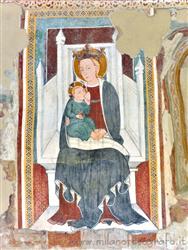|
Lenta (Vercelli, Italy): Church of Saint Mary of the Fields
|
|
|
Show an other place around Milan worth a visit: |
 The Church of Saint Mary of the Fields ("Santa Maria dei Campi"), also known as the Church of the Madonna of the Countryside, is located just outside the town of Lenta, on the Vercelli/Valsesia state road, actually in the middle of the fields. The Church of Saint Mary of the Fields ("Santa Maria dei Campi"), also known as the Church of the Madonna of the Countryside, is located just outside the town of Lenta, on the Vercelli/Valsesia state road, actually in the middle of the fields.
Curiously, there are many parallels between it and the more important St Stephen's Church, as both are antique churches with two naves, with the left one being older and the right one added only later.
The church is mentioned for the first time in a document of 1214. Various stylistic elements, in particular the archaic decoration with hanging arches of the left apse and the rhomboidal plan of the left nave, converging towards the apse, however lead us to think that the left side is much older and dates back to the eleventh if not the tenth century. The facade, on the other hand, would be less ancient, since it could date back to the twelfth century and have been rebuilt in place of an older one.
The left half of the church would therefore even be proto-Romanesque, while the right side is from the Gothic period.
Currently the building is completely plastered externally, which undoubtedly helps to preserve it, but prevents further studies of the structures so as to shed greater light on its history.
In the gabled façade there are two entrances, one for each nave. To the left of each is a rectangular window, while above, in higher position, there is an oculus. Note that the left half of the facade is divided by pilasters in three parts, while the right half is flat, further evidence of the fact that the two parts were built in different periods.
On the right side wall there are two rectangular windows of considerable size, while on the left side there are some monoforas, however walled up on the inside.
In the center of the facade, in a frame with red and white bands,
with a floral frieze that pretends to be gilded, there is a fresco, unfortunately very ruined, of Saint Christopher with the Child. It is estimated to have been painted sometime after the mid-fifteenth century.
The two apses are interesting, as they are similar, but with important differences. Both are in fact semicircular. The one on the left, however, is higher and occupies a larger area. It is also externally divided by pilasters connected above by pairs of hanging arches. Only two simple small arches of relatively large dimensions between two adjacent pilasters are a typically archaic character, confirming the fact that the left apse is very ancient. The one on the right instead has a band of much smaller hanging arches placed immediately under the junction of the roof, while the pilasters are absent. In the left apse there are also single lancet windows (only two, however, still open), while the one on the right has vertical rectangular windows, all walled up internally.
Inside, the two naves are divided by what remains of the thick right wall of the original church with a single nave, in which large arched passages were simply opened.
There are several noteworthy frescoes:
Left apse (Fig. 4)
- The apsidal basin is occupied by a seventeenth-century Annunciation, with the Angel on the left and the Virgin on the right, surmounted by an Eternal Father with outstretched arms. At the bottom right appears a corner of the older fresco above which the present one was painted.
All the other frescoes in the left apse were instead painted in the period between the fifteenth and sixteenth century.
- At the center of the wall there is an Nursing Madonna enthroned (larger picture.) in Gothic style, which is particularly well preserved and of a good artistic level.
- On the left there is another Madonna enthroned with child, unfortunately very damaged. It is attributed to the De Bosis workshop and would therefore date back to the period between the fifteenth and sixteenth centuries.
- On the right, however, there is a panel depicting, starting from the left, Saint Lucia, St. Denis and St. Sebastian, attributed to a Milanese or Lombard workshop.
Right apse
- There are the remains of a single votive fresco with four characters. The fresco is inside a frame with red floral motifs and is unfortunately now almost illegible.
Counterfaçade
- Fresco of modest workmanship from a period probably between the fifteenth and sixteenth centuries and depicting a Saint Anthony the abbot (Fig. 5). It is attributed to a painter of the Novara school. The peculiarity of this fresco is represented by the large number of graffiti containing references to particular historical events engraved on the robe of the saint. Curiously most of these graffiti seem to be attributable to the same hand. The presence of various errors and inaccuracies leads us to believe that they were largely made in a very short chronological period, perhaps in the nineteenth century, recording events that occurred quite a long time before.
Categories: Places of historical value of artistic value
45.55297897656032, 8.379710982811867 |
Further pictures of Church of Saint Mary of the Fields in the section Photography |